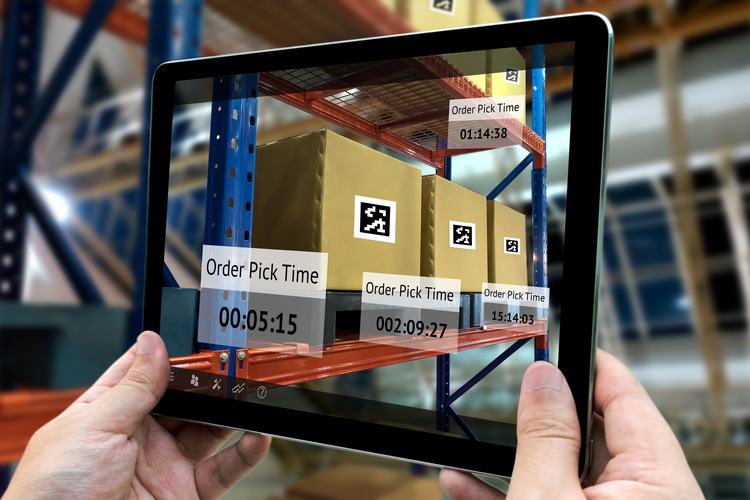Machine learning is a form of artificial intelligence based on teaching neural networks to identify and adapt to known patterns on the fly.
Copyright by www.thomasnet.com
 Looking deeper into the core operations of warehousing , machine learning can apply to facility-wide production standards, optimize for specific metrics, and ensure a continuously improving user experience. How Does Machine Learning Tie Into Warehouse Management Systems?
Looking deeper into the core operations of warehousing , machine learning can apply to facility-wide production standards, optimize for specific metrics, and ensure a continuously improving user experience. How Does Machine Learning Tie Into Warehouse Management Systems?
Warehouses are dynamic environments. Machine learning software combines new and incoming information with pre-existing training to further hone pattern-based predictions including picking and routing info, customer demand, storage usage, and similar data sets to ensure all shipments are fulfilled on time .
Training neural networks with information from workers and historical data can identify ways in which workers can improve. While training machines can initially be resource-intensive, it is often less costly than hiring new human workers.
In the long-term, machine learning can lower operational costs because training can be replicated on machines in a way that is not possible with humans who must be trained individually and on an ongoing basis.
Warehouse management systems (WMS) are an excellent application for machine learning because consumer demand changes rapidly, causing overstocking and product scarcity in warehouses around the world. Overstocking is a particular concern because warehouse space availability is at 7% , the lowest since 2000.
Machine learning can not only predict these changes on the data side but can also accelerate the pace of adaptation on the production side. Production-side machine learning encompasses storage optimization, picking routes, and even picking. Other facilities are evaluating machine learning and machine vision applications in the docking and loading/unloading carrier shipments. Machines can also be used to optimize shipment aggregation and sorting processes as the technology matures.
Thank you for reading this post, don't forget to subscribe to our AI NAVIGATOR!
How Does Machine Learning Improve Productivity?
Productivity metrics vary between businesses — some may favor order fulfillment over accuracy or vice versa, as well as a wide array of other potential indicators of productivity. Machine learning enables neural networks to break down whatever productivity expectations a business utilizes, recognize patterns, and enhance performance over time.
Common productivity metrics include:
- Time to fulfillment
- Fulfillment accuracy
- Shipment utilization (fullness of carrier containers)
- Idle time
Since their purchase of Kiva, Amazon has saved more than $22 million in each facility where Kiva robots are utilized for order fulfillment.
Other companies who reported success with machine learning and warehouse automation include Merck, which achieved a 50% reduction in product carrying costs, and RRD, who helps other companies adapt to the artificial intelligence landscape. Ken O’Brien, Executive Vice President and Chief Information Officer of RRD, “What sets us apart is our ability to take these technologies — from artificial intelligence to business process automation to machine learning — and demonstrate meaningful business results that improve our own internal processes and do the same for our clients.” […]
Read more – www.thomasnet.com


Machine learning is a form of artificial intelligence based on teaching neural networks to identify and adapt to known patterns on the fly.
Copyright by www.thomasnet.com
Warehouses are dynamic environments. Machine learning software combines new and incoming information with pre-existing training to further hone pattern-based predictions including picking and routing info, customer demand, storage usage, and similar data sets to ensure all shipments are fulfilled on time .
Training neural networks with information from workers and historical data can identify ways in which workers can improve. While training machines can initially be resource-intensive, it is often less costly than hiring new human workers.
In the long-term, machine learning can lower operational costs because training can be replicated on machines in a way that is not possible with humans who must be trained individually and on an ongoing basis.
Warehouse management systems (WMS) are an excellent application for machine learning because consumer demand changes rapidly, causing overstocking and product scarcity in warehouses around the world. Overstocking is a particular concern because warehouse space availability is at 7% , the lowest since 2000.
Machine learning can not only predict these changes on the data side but can also accelerate the pace of adaptation on the production side. Production-side machine learning encompasses storage optimization, picking routes, and even picking. Other facilities are evaluating machine learning and machine vision applications in the docking and loading/unloading carrier shipments. Machines can also be used to optimize shipment aggregation and sorting processes as the technology matures.
Thank you for reading this post, don't forget to subscribe to our AI NAVIGATOR!
How Does Machine Learning Improve Productivity?
Productivity metrics vary between businesses — some may favor order fulfillment over accuracy or vice versa, as well as a wide array of other potential indicators of productivity. Machine learning enables neural networks to break down whatever productivity expectations a business utilizes, recognize patterns, and enhance performance over time.
Common productivity metrics include:
Since their purchase of Kiva, Amazon has saved more than $22 million in each facility where Kiva robots are utilized for order fulfillment.
Other companies who reported success with machine learning and warehouse automation include Merck, which achieved a 50% reduction in product carrying costs, and RRD, who helps other companies adapt to the artificial intelligence landscape. Ken O’Brien, Executive Vice President and Chief Information Officer of RRD, “What sets us apart is our ability to take these technologies — from artificial intelligence to business process automation to machine learning — and demonstrate meaningful business results that improve our own internal processes and do the same for our clients.” […]
Read more – www.thomasnet.com
Share this: